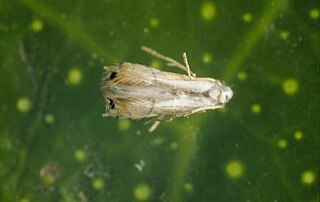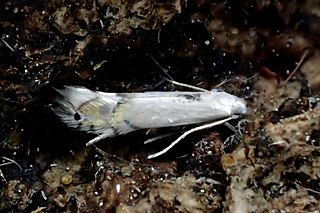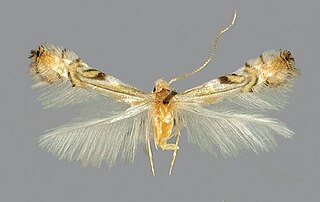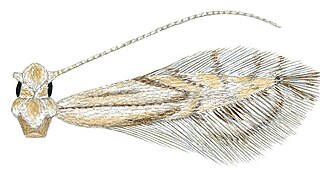Related Research Articles

The citrus leafminer is a moth of the family Gracillariidae. It is also known as CLM in agriculture. It was described by Henry Tibbats Stainton from India in 1856. It was first found in Florida, United States, in 1993, but is now found all over the world, including Argentina, Australia, Brazil, China, Corsica, Costa Rica, Cuba, India, Israel, Madeira, Malaysia, Mauritius, Mexico, the Philippines, South Africa, Spain, Sri Lanka and other parts of the United States.

Phyllocnistis labyrinthella is a moth of the family Gracillariidae. It is found in most of continental Europe, except Italy, the Mediterranean Islands and parts of the Balkan Peninsula.

Phyllocnistis is a genus of moths in the family Gracillariidae.

Phyllocnistis saligna is a moth of the family Gracillariidae. It is known from almost all Europe, as well as India, Sri Lanka, La Réunion and South Africa.

Phyllocnistis xenia is a moth of the family Gracillariidae. It is found from Great Britain to Bulgaria and from Poland to the Iberian Peninsula and Italy.

Phyllocnistis valentinensis is a moth of the family Gracillariidae. It is known from Spain, Greece and Bulgaria.
Phyllocnistis ampelopsiella is a moth of the family Gracillariidae, known from Québec and the United States.
Phyllocnistis amydropa is a moth of the family Gracillariidae, known from Maharashtra, India.
Phyllocnistis cirrhophanes is a moth of the family Gracillariidae, known from Karnataka, India.

Phyllocnistis insignis is a moth of the family Gracillariidae, found throughout the United States.
Phyllocnistis liquidambarisella is a moth of the family Gracillariidae, known from the United States. The hostplant for the species is Liquidambar styraciflua. They mine the leaves of their host plant. The mine has the form of a long, winding, linear mine on the upperside of the leaf. It is rather indistinct, without any central line of frass.
Phyllocnistis lucernifera is a moth of the family Gracillariidae, known from Maharashtra, India. They mine the leaves of their host plant. The mine has the form of a wandering zigzag gallery on the under surface of the leaf.
Phyllocnistis stereograpta is a moth of the family Gracillariidae, known from Maharashtra, India.
Phyllocnistis synglypta is a moth of the family Gracillariidae, known from Maharashtra and Karnataka, India, as well as Malaysia.

Phyllocnistis vitifoliella is a moth of the family Gracillariidae, known from Québec and the United States.
Phyllocnistis voutei is a moth of the family Gracillariidae, known from Java, Indonesia.

Phyllocnistis hyperpersea is a moth of the family Gracillariidae. It is found from Nansemond and Virginia Beach Counties in Virginia, south along the lowland Atlantic coastal region to the Florida Everglades. It might have a much wider range, since material which might belong to this species has been recorded from Honduras and Mexico.

Phyllocnistis subpersea is a moth of the family Gracillariidae. It is found in the Dade and Monroe Counties of Florida. Mines of what appear to be this species have been found as far north as the Green Swamp in coastal South Carolina.

Phyllocnistis longipalpa is a moth of the family Gracillariidae. It is known only from the Everglades National Park, Dade County, and along the Loop Road near Tamarind Hammock, Monroe County, Florida.

Phyllocnistis perseafolia is a moth of the family Gracillariidae. It is known only from the type locality in the Department of Caldas, west-central Colombia, but probably widespread over northern South America wherever avocado is cultivated.
References
- 1 2 Phyllocnistis intermediella Busck, 1900 at the Global Taxonomic Database of Gracillariidae (Lepidoptera).